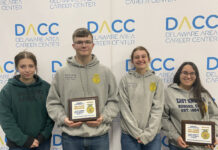WOOSTER, Ohio — “We can always find bees, but we can’t always find beekeepers,” said Dr. James Tew, Ohio State University Extension bee specialist. “I can’t look at people and tell what makes them become beekeepers.”
Speaker
Tew was the keynote speaker at the 2011 Ohio State University Extension and Tri-County Beekeepers’ Workshop, March 4-5, at the Ohio Agricultural Research and Development Center.
Tew told an audience of close to 1,000 people that the beekeeping industry is going through the most vibrant transition in its history.
While the industry has seen a migration of large hives out West to handle pollination needs, eastern states still remain passionate about beekeeping and continue to move the industry forward.
Standards
Tew said that prior to 1851, bees were kept using gum and boxes. By 1880 to 1890, hives became standardized and smokers were developed.
By 1914 to 1918, World War I brought about the birth of commercial beekeepers and the use of honey as a sweetener because sugar was rationed. Honey was also recognized for its health benefits.
By 1939 to 1945, World War II again brought about the use of honey as a sweetener due to sugar rationing. Bees were recognized as pollinators and beekeepers were deferred from military service in order to work on raising food for the war effort.
Beeswax was also in demand as a lubricant and as a means of waterproofing materials needed in the war effort. Honey again was recognized for its health benefits.
Back to nature
Tew said that by 1975 to 1980, the height of the organic food craze, people were looking for low salt, no sugar food and looking for natural sweeteners. They also did not want pesticides used on their food.
African bees
The industry went into a downswing when Africanized bees came on the scene, and was compounded by varroa mite and Colony Collapse Disease.
By 2006, beekeeping had undergone another transition as the Internet gained momentum in educating beekeepers on varroa mites and Colony Collapse Disease. But beekeeping also became fashionable again as municipalities were changing their zoning restrictions to allow gardening and beekeeping in their cities.
“This changed everything we know about beekeeping,” Tew said. “The Internet has had a major impact on beekeeping.
“Beekeepers have always used ‘crowd source.’ The reason this industry has evolved is because they are willing to share information.”
Social media
And when beekeepers linked with social media, they built a network of at least 125,000 people who share the same enthusiasm for bees.
“Crowd sourcing helps keep us growing as we share information,” he said. “This is a powerful tool, and it makes you powerful because you have what it takes to think outside the box and find solutions to problems such as varroa mites or Colony Collapse Disease. It is OK to use your imagination to solve problems.”
Tew encouraged the audience to play with concepts and not be afraid to make a mistake.
“Collect your mistakes,” he said. “As a group, you can solve today’s problems.”










Urban beekeeping is growing in leaps and bounds. This year Greater Cleveland Beekeepers had over 80 “newbees” for their beginning beekeeping classes. Because of this interest and their intense desire to support sustainable agriculture, Balwin-Wallace College is hosting GCBA’s first NEO HONEYBEE CONFERENCE on May 14th, 2011. Our featured speaker is Dr. Tom Seeley from Cornell University, author of “Honeybee Democracy”. Yes, beekeepers are coming back…and strong…all because we wish to learn, share our mistakes, celebrate our wins and collaborate with other beekeepers to solve problems. The colony has taught us well! For more information on the conference please visit: http://www.neohoneybees.com.